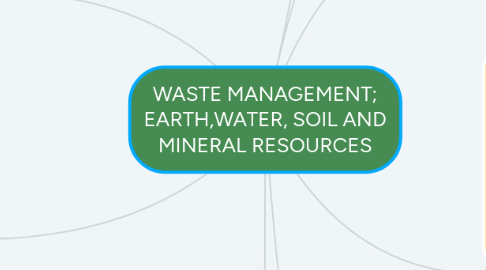
1. Soil minerals serve as both sources and sinks of essential plant nutrients. As primary minerals that originally formed at high temperatures and pressures in igneous and metamorphic rocks are weathered in soils, they release plant nutrients into the soil solution.
1.1. Soils are complex mixtures of minerals, water, air, organic matter, and countless organisms that are the decaying remains of once-living things. It forms at the surface of land. it is called the skin of the earth. Soil is capable of supporting plant life and is vital to life on earth.
1.1.1. Specialized erosion control practices have been developed for use within stream channels, forest areas, and construction sites.
1.1.2. One of the most effective means of reducing erosion is to maintain a vegetative or residue cover on the soil surface.
1.2. Erosion is a process where natural forces like water, wind, ice, and gravity wear away rocks and soil. It is a geological process, and part of the rock cycle. Erosion occurs at the Earth's surface, and has no effect on the Earth's mantle and core.
1.2.1. Excessive erosion can threaten the production of agricultural and forest products.
1.2.2. Erosion may also impact water conveyance and storage structures, and contribute to pollution from land surfaces.
2. Minerals are solid substances that are present in nature and can be made of one element or more elements combined together (chemical compounds). Gold, Silver and carbon are elements that form minerals on their own. They are called native elements.
2.1. Mineral resource is the mineral deposit consisting of useful concentration that may or may not exceed economic cost for obtaining the valuable minerals. The technological process, the needs of the economy and prices in the market, depends on whether and when the rock/mineral becomes raw material.
3. Soil serves as a reservoir of water and nutrients, as a medium for the filtration and breakdown of injurious wastes, and as a participant in the cycling of carbon and other elements through the global ecosystem.
3.1. Soil is especially vulnerable to erosion if it is bare or exposed.
3.1.1. Human Activities that leave the soil exposed and speed up erosion:
3.1.1.1. Agricultural Depletion,
3.1.1.2. Overgrazing Animals
3.1.1.3. Deforestation,
3.1.1.4. Development and Expansion
3.1.1.5. Mining
3.1.2. Mining is an economically important industry for many countries but it comes at a cost. Mining can result in the pollution of natural resources, harm to the biodiversity of habitats, and erosion of the land.
3.1.3. Mining is the extraction of valuable minerals or other geological materials from the earth, usually from an ore body, lode, vein, seam, reef or placer deposit. These deposits form a mineralized package that is of economic interest to the miner.
3.1.4. Ores recovered by mining include metals, coal, oil shale, gemstones, limestone, chalk, dimension stone, rock salt, potash, gravel, and clay.
3.1.5. Mining techniques can be divided into two common excavation types: surface mining and sub-surface (underground) mining. Today, surface mining is much more common, and produces, for example, 85% of minerals (excluding petroleum and natural gas) in the United States, including 98% of metallic ores.

